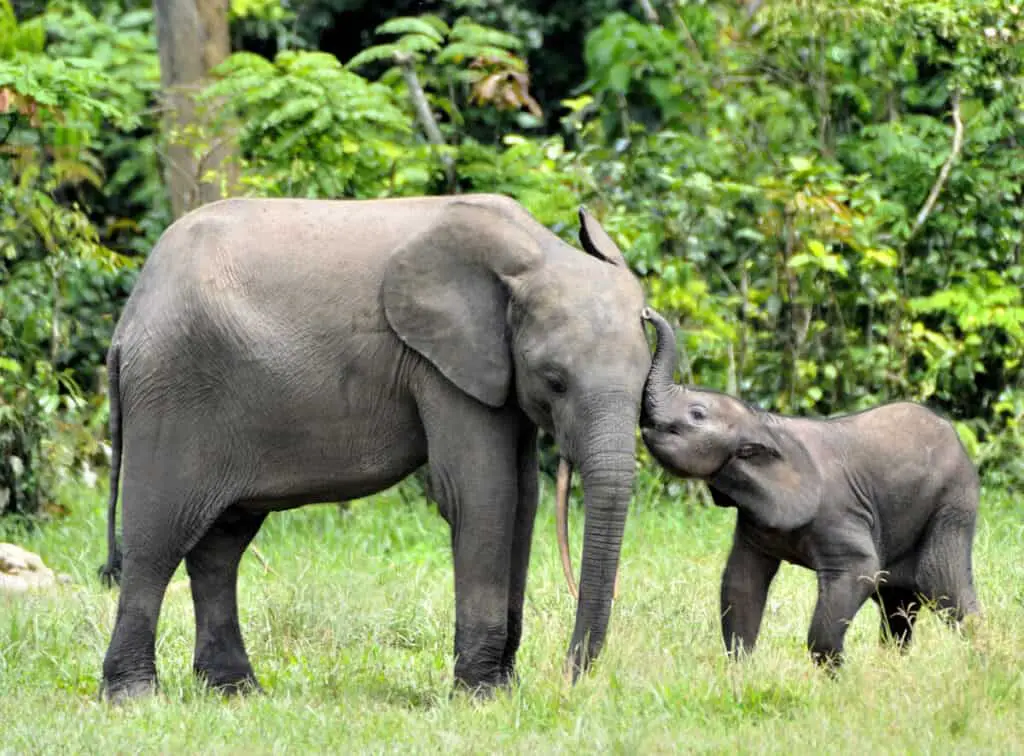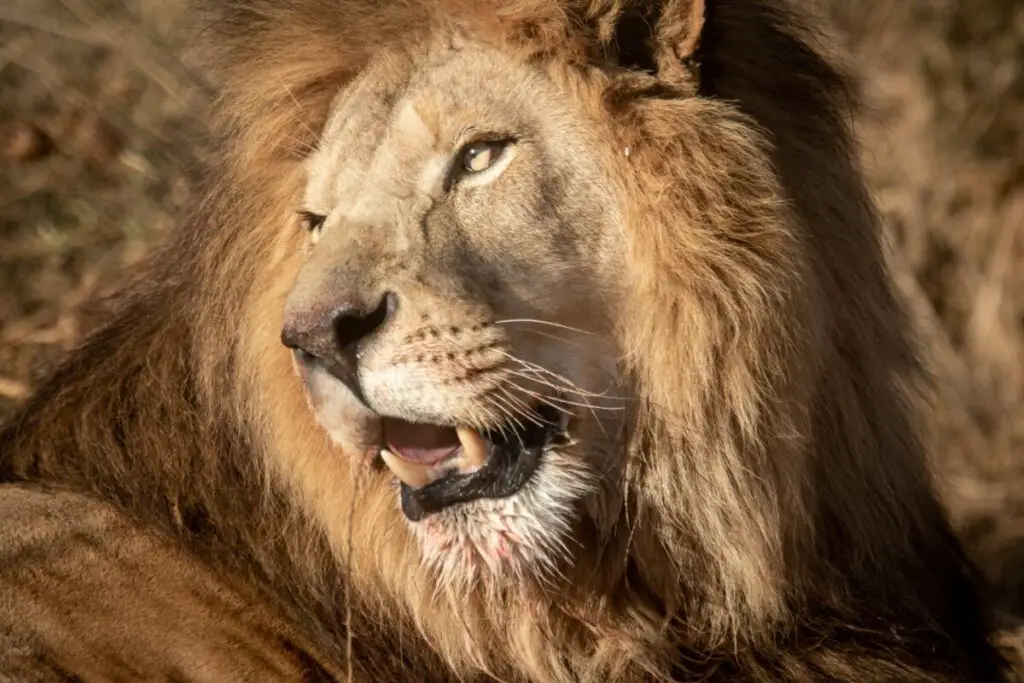African elephants are the largest land animals on Earth, with mature males weighing up to 14,000 pounds and standing nearly ten feet tall. These gentle giants are known for their intelligence, emotional complexity, and close family ties.
Unfortunately, they also face a significant threat from predators that prey upon them throughout their range across sub-Saharan Africa.
The primary natural predator of African elephants is the lion (Panthera leo), which typically hunts juveniles or weak and vulnerable individuals in herds. However, other carnivores may also target these massive herbivores under certain circumstances.
Understanding the ecology of elephant predation can help conservationists develop strategies to protect this iconic species and their fragile ecosystems.

The Role Of Lions In Elephant Predation
African elephants are massive creatures that can weigh up to 12,000 pounds and stand at a height of 10-13 feet. Despite their size, they have predators in the wild, with lions being one of them.
Lions are known for their hunting habits, which usually involve attacking weak or vulnerable prey such as young or injured animals. However, when it comes to African elephants, lion predation is rare due to the elephant’s formidable defense mechanisms.
Lions may attempt to take down an elephant calf if they spot one separated from its herd. However, adult elephants will fiercely protect their young by forming a defensive circle around them and using their trunks and tusks to fend off attackers.
Additionally, elephants’ large size makes it difficult for lions to bring them down without risking injury themselves. While lion attacks on adult elephants have been documented in some cases, they are not common occurrences in the wild.
Other Carnivores That Prey On Elephants
While lions and crocodiles are known to prey on African elephants, there are other carnivores that also pose a threat to these massive herbivores.
In some cases, solitary predators such as leopards and hyenas have been observed attacking lone elephants. This type of behavior may be due to the predator’s desperation for food or territorial defense against intruders.
Lone elephant survival in areas with high predator populations can depend heavily on their ability to navigate through complex predator-prey dynamics. For example, it has been noted that female elephants tend to group together during periods of increased predation risk, likely providing protection from potential attackers.
However, despite such measures, instances of successful attacks by various predators still occur. The interplay between large herbivore populations and their predators is an ongoing area of research in ecology and conservation biology.
Juvenile Vulnerability To Predation
Other Carnivores That Prey on Elephants have been identified in the previous section. However, African elephants face threats not only from carnivorous animals but also from other predators such as humans and poachers. These large mammals are often hunted for their ivory tusks or killed due to human-wildlife conflict.
Juvenile Vulnerability to Predation is a significant concern since young elephants are particularly vulnerable to attacks by lions, hyenas, and crocodiles. This vulnerability results in high mortality rates among elephant calves.
Nevertheless, African elephant populations have developed various Survival tactics that help them protect themselves from predators. One of these survival tactics includes staying close together while grazing or traveling in groups. Additionally, maternal protection plays a critical role in calf survival. Maternal herd members fiercely defend their offspring against potential attackers using physical aggression or vocal communication methods like trumpeting calls to alert other herd members of danger.
Hunting Strategies Of Carnivores
Carnivores have evolved a range of hunting strategies to capture their prey, with each species exhibiting unique adaptations that enhance their success in the hunt. Predators compete fiercely for resources like food and territory, which can affect their ability to predate on certain prey species. In Africa, carnivores such as lions, hyenas, leopards, and wild dogs are known predators of African elephants.
Elephants are not an easy target for most carnivores due to their large size and strength. However, juveniles and weak or injured adults may still fall victim to predation. Lions are the primary predator of young elephants while adult elephants face more danger from packs of hyenas or solitary leopards. Wild dogs also pose a threat to both juvenile and adult elephants but tend to avoid them when possible due to the potential risk involved in attacking such large animals. The table below summarizes some of the key characteristics of these elephant predators:
| Predator | Hunting Strategy | Prey Availability |
|---|---|---|
| Lion | Hunts in prides; uses stealth and ambush tactics; hunts at night | Juvenile elephants; weakened or injured adults |
| Hyena | Hunts in packs; scavenges frequently but will actively hunt when necessary | Weakened or injured adults |
| Leopard | Solitary hunters; use camouflage and surprise attacks | Adult males during mating season; calves separated from herd |
| Wild Dog | Hunts in packs using cooperative hunting techniques | Opportunistic: will attack all age classes if desperate |
Predator competition is fierce among carnivores, especially those that share similar diets or habitats. For example, lions often compete with spotted hyenas over access to carrion left by other predators or killed by natural causes.
This competition can impact predator behavior towards certain prey species depending on availability. If one predator has greater success capturing a particular prey item than another competitor does, they may shift their focus accordingly. As such, the presence and abundance of elephant prey can influence carnivore populations in certain areas.

The Impact Of Human Activities On Elephant Predation
Human activities have significantly impacted the predation of African elephants. Human wildlife conflict has led to an increase in poaching and hunting, resulting in a decline in elephant populations across Africa. Elephants are hunted for their ivory tusks, which are highly prized by illegal markets. This human activity has disrupted the ecological balance of ecosystems where elephants live.
Furthermore, human activities such as deforestation and habitat destruction have displaced predators that would normally prey on elephants. Consequently, predators such as lions and hyenas now rely more heavily on preying on other species instead of elephants. As a result, this can lead to overpopulation of certain animal species, further disrupting the ecosystem’s natural equilibrium.
The lack of predator-prey relationships disrupts the food chain. Overpopulation of some herbivorous animals could cause competition for resources.
Displacement of large carnivores leads them closer to human settlements increasing potential risks to humans. Imbalances in ecosystems could lead to loss or extinction of plant or animal species.
Overall, it is essential that we acknowledge our impact on elephant predation and take measures to address these issues while promoting ecological balance.
Conservation Efforts To Protect Elephants From Predation
To safeguard African elephants from predators, conservation strategies and anti-poaching efforts are being undertaken. One of the primary objectives is to reduce elephant-human conflict, which can lead to retaliatory killings by farmers or villagers whose crops have been destroyed.
This has led to initiatives like creating buffer zones around national parks and reserves, where human activities are carefully managed to minimize contact with elephants.
Another significant effort is anti-poaching measures aimed at curbing illegal hunting for ivory trade. Poachers pose a grave threat to not only elephants but also other wildlife species living in their natural habitat. To combat this menace, various organizations have stepped up their field operations using technology such as drones equipped with thermal imaging cameras that can detect poacher’s movements even during nighttime.
Furthermore, educating local communities about the importance of conserving these gentle giants and raising awareness globally through social media campaigns have helped generate support towards elephant protection programs.
As a result of these initiatives, there has been an improvement in populations in some areas; however, much still needs to be done before we can say that African elephants are entirely out of danger. Thus it remains crucial to continue implementing effective management practices and constant monitoring while promoting sustainable tourism that benefits both humans and elephants alike – only then can we hope for long-term success in protecting these magnificent animals from all forms of predation.
Future Directions For Research On Elephant Predators
Conservation efforts to protect elephants from predation have been largely focused on poaching. However, it is important to also consider the natural predators of African elephants.
Predation has a significant impact on elephant populations and predator-prey dynamics play an essential role in sustaining ecosystem balance.
Ecological factors such as habitat loss, human encroachment, and climate change can affect predator-prey relationships. The following are possible predators of African elephants:
- Lions: These big cats may attack young or weakened elephants.
- Crocodiles: Elephants often cross rivers where crocodiles lie in wait for prey.
- Hyenas: They scavenge carcasses but will also hunt small and weak individuals.
- Wild dogs: They work together to take down their prey which sometimes includes elephants.
- Humans: While not a natural predator, humans pose one of the greatest threats to elephant populations through poaching.
Future directions for research on elephant predators should focus on understanding the ecological factors that influence these relationships. Factors like habitat fragmentation and climate change could alter the distribution and behavior of both predators and prey.
Additionally, studying how anthropogenic activities such as land use change affect these interactions would be valuable in informing conservation strategies aimed at protecting both African elephants and their predators.
Conclusion
African elephants, despite their size and strength, are not immune to predation. Lions are the primary predators of adult elephants in Africa through coordinated attacks on isolated individuals or desperate attempts to take down a weakened elephant.
Other carnivores such as hyenas, wild dogs, and crocodiles may also prey on young or injured elephants. Juvenile elephants are particularly vulnerable to predation due to their smaller size and lack of experience.
Carnivores use various hunting strategies such as ambush tactics, persistence hunting, and pack cooperation depending on their social structure and prey availability. Human activities such as habitat destruction and poaching have disrupted natural predator-prey relationships by altering ecosystem dynamics and reducing populations of both predators and prey.
Conservation efforts that focus on restoring habitats, limiting human-elephant conflict, and protecting important wildlife corridors can help reduce elephant mortality from predation.
Future research should investigate how changes in predator behavior affect elephant population dynamics over time. Understanding these complex ecological interactions is crucial for developing effective conservation strategies that balance biodiversity protection with human needs.
By addressing the underlying drivers of elephant predation, we can ensure the survival of this iconic species for generations to come.

